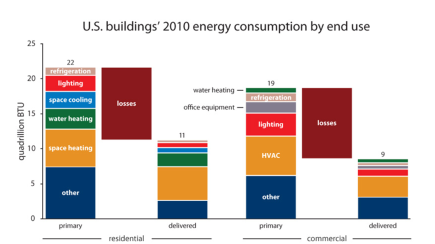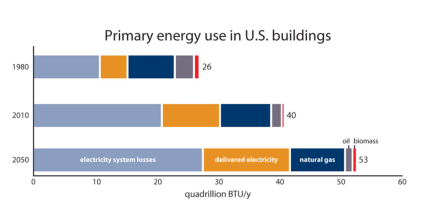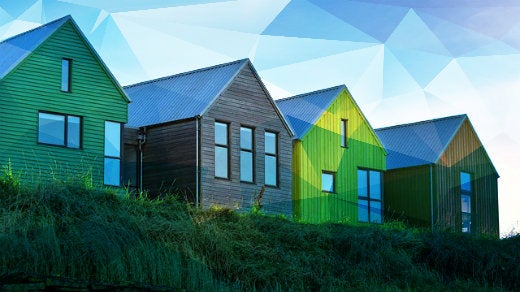There are (at least) two ways to look at the move to more green power generation: the supply side and the demand side. The supply side emphasizes a transition from fossil fuels to renewable energy and carbon-free energy. The demand side, however, looks at how to reduce energy use, preferably without hurting the current standard of living.
This article will focus on making changes from the demand side.
The business opportunities in reducing energy demand
Imagine two salespeople who sell electricity for a utility company. They decide they don't want to promote or sell electricity use anymore because of its negative environmental and climate change impact. They retire and then decide they want to work together to assemble an Open Organization Community to reduce energy consumption in a way that does not adversely impact people's standard of living. Simply put, they want to consult and collaborate with energy users on reducing waste with the indirect goal of eliminating the use of fossil fuels as an energy source by 2050.
These retired salespeople happened to read my article "A 5-step plan to encourage your team to make changes on your project" and see my presentation Creating change. After thinking about that content, they decide to work together quietly at first, as they know many of their friends at the utility company might resist and create barriers to their project. The project is very fragile initially, and the utility company is very powerful and wealthy, so they decide to visit trusted major electricity users very narrowly and expand from there.
The imaginary energy efficiency consultants also read the book Reinventing Fire: Bold Business Solutions for the New Energy Era by Amory B. Lovins. The book offers methods to eliminate the use of fossil fuels by 2050, thus "reinventing fire": moving from old power sources to new ones.
Reinventing Fire doesn't consider environmental approaches and presents very few legislative approaches. Instead, the authors believe there are significant business opportunities in the energy use and generation sectors, and businesses can make huge profits through energy waste reduction and efficient energy use. By applying open organization principles, businesses that address how energy is consumed and produced now and in the future could be very useful to any organization.
Although my imaginary consultants are interested in regional energy efficiency more than profits, they decide to include and commission Amory Lovins and his organization, Rocky Mountain Institute, as collaborators and advisors for this community on reducing energy waste. They call their project The Reinventing Fire Community.
One of these two imaginary experts specialized in selling electricity to factories. The other specialized in selling electricity to large and small buildings and single-unit homes. They know that one of the big problems with energy costs is that most people don't think about it. And that's what they want to change.
[ Related read How open organizations can harness energy disruptions ]
In many companies, energy is considered a fixed overhead cost, so it isn't tracked. Individuals often consider other expenses, like house or car payments, far more important. However, if monitoring of all their energy use in every specific location were available, instances of waste in each room and function would be transparent and easier to reduce.
In this article, I will discuss how the consultant who sold electricity to buildings and homes uses open organization principles. In a future article, I will discuss the factory consultant's activities.
Building and home energy consultant
This consultant wants to go to large and small non-industrial businesses, homes, and housing communities (starting with their previous electricity users) to offer suggestions on reducing yearly energy expenses by at least 10-50%. If equipment investment is required, they promise that the equipment is sure to pay for itself in 3-5 years of energy expense savings.
There are some conditions, however, for working together:
- The facility owners must be as open as possible about their current energy use and expenses.
- The consultant will not give anyone the information they receive except for trusted consultants they work with to generate the very best proposals.
- There's no charge for the consulting, as they only want to reduce energy use in the community, and at this stage, they don't know how valuable that will be.
- The consultant would like a performance report and a general testimonial letter from the user at the end of 2 years explaining how much the energy user's bill has been reduced by.
Energy use and waste
How can the home and building consultant put all the open organization principles of Community, Transparency, Collaboration, Inclusion, and Adaptability to further use?
First, the building energy consultant makes an appointment with their most trusted electricity user and explains that they want the user to save money. To make the problem transparent, the consultant presents the amount of primary energy use in US buildings now and points out that if nothing changes, it will get worse in the years ahead:

From the book Reinventing Fire by Amory B. Lovins (Ron MacFarland, CC BY-SA 4.0)
The above chart, from Reinventing Fire, shows that between 1980 and 2010 US, residential and commercial building energy use grew by 54%. Between 2010 and 2050, it is projected to grow by another 33%. After looking at this chart, the electricity user is convinced that they should study energy waste and agrees to the terms of the consultancy.
The consultant then explains that building energy use falls into six groups, with the first four using the most energy:
- Space heating
- Water heating
- Space cooling
- Lighting
- Electronics
- Appliances
On average, improvement in existing buildings can lead to a reduced energy use bill of 30-40%, with payback in 3-4 years. That's the goal they are targeting, depending on where the electricity user's building uses the most energy. Each function's energy use must be measured to determine where the greatest waste is. The problems must be made transparent; then, they can be addressed and controlled.
Using Reinventing Fire as a model, they explain just how much loss and waste there is in energy from power utility to user. Much of building energy is wasted, so providing reduction methods could save a lot of money.

From the book Reinventing Fire by Amory B. Lovins (Ron MacFarland, CC BY-SA 4.0)
The authors explain:
"The six key energy uses are different in residential and commercial buildings. Electrical uses entail far more primary than delivered energy because of the roughly threefold losses in converting power-plant fuel to electricity and the 7% average losses in delivering electricity to your meter (plus a few percentage points more lost in the building's wiring). Primary energy use drives your building's climate impact; delivered energy drives its operating costs."
The consultant also shows the electricity user the data above from Reinventing Fire, which confirms that it's worth the investment in energy-saving measures. In addition to direct cost reduction, users also benefit from increased resiliency and adaptability to sudden power failures or disruption—not to mention the reduction of greenhouse gases. If the investment amount is a concern, the consultant could help the user find financing with favorable incentives that promote climate change mitigation projects.
The consultant wants to collaborate in several areas, including wall insulation, window sealing and material, air moisture controls, energy use monitoring and controls for comparisons with similar structures, and electrification of both housing and transportation. One avenue for this assessment is the current smartphone apps that can diagnose building energy use and recommend what to install to mitigate waste.
Repairing lighting and air conditioner controls, installing weather seals on all doors, and adding occupancy sensors can quickly generate electricity savings. Lighting occupancy sensors reduce waste from lights being on when no one is in a room. These savings could make a business extremely profitable, even if overall business is slow.
Finding the waste
In the interest of transparency, the consultant presents new building technologies now available. The electricity user might not want or need them all, but this information exposure leads to collaboration and adaptability where appropriate. They reviews these categories:
- Smart windows: Windows that darken in response to a small electric current or heat, such as Pleotint, RavenBrick, "AdaptivE" windows, or thermochromic windows, let in as much as five times more solar heat in the winter and less on hot summer days, which can reduce temperature expenses by 30%.
- Enhanced evaporation: Spraying water into hot air or drying humid air enhances cooling.
- Insulation: Extraordinarily light and fluffy silica-based gels are available and are six times better than simple plastic foam. They’re also thinner. This insulation could be placed on window frames or thin walls and even painted on surfaces to act as a thermal barrier.
- Phase-change materials: Heat-absorbing materials that melt and then harden with temperature changes influence outside-to-inside heat differences. They slow temperature increases during the day by absorbing heat and storing it. Then, the heat is slowly released at night, so indoor daytime and nighttime temperatures are closer together.
- Light-emitting diodes (LEDs): Next-generation LEDs will replace semiconductors with organic compounds, called OLEDs. They are already in cellphones and cameras. Users can also consider where the light is shining. Is it exactly where and when it is needed? Can excess lighting be eliminated? Could reflection devices be applied to direct light where needed without increasing electricity use? Can it be turned off automatically when not in use?
- Efficient rotors: Pumps, fans, blowers, turbines, and propellers are a significant source of energy use. Improving their shape dramatically reduces energy use for the same function. For example, these improvements can reduce energy use by 30% in computer cooling fans.
- Appliances: Stove surfaces that hold their shape for better heat transfer, smarter controls, and heat-trapping pots are being developed to use less electricity for the same function.
- Heat pumps: Miniature heat pumps that both heat and cool are in development. These are almost three times more effective than standard water heaters and water-heating heat pumps.
- Sensors: The consultant can look around the electricity user's buildings to see where sensors could be located for energy-use measuring and control.
- Power source. Should other energy sources be explored? Options could include electricity from a mini power grid in the neighborhood, solar panels on a roof or an overhang, or trading in an internal combustion engine vehicle for an electric car. These actions could make the user more of an electricity supplier than just a consumer.
As our consultant reviews these suggestions while looking around the electricity user's buildings, there may be cases that require specialist support. This is where inclusivity comes in. They want to install the best and most cost-effective equipment, which might require further technical support. In this case, collaboration with the Rocky Mountain Institute will be important.
Right-sizing
Other reductions can be explored by looking at the total energy requirements after installing advanced materials. With the advantages of advanced insulation and superwindows, the term "passive heating" comes up. It means that no energy is required to keep a room comfortable. The reductions in heating equipment costs may balance the cost of any superwindow, superinsulation, or ventilation installations. They could save 99% of space- and water-heating energy.
Superwindows let in more light but block heat from entering, keeping the heat in during the winter and keeping sunlight heat out in the summer. That reduces the need for powerful energy-consuming air conditioners, so a smaller cooling and heating system can be installed.
In this theoretical example, the energy user could then be certified as having an advanced passive heating system. Internationally, there is a passive structure certification system called Passivhaus, and they could also explore US LEED Certification. In Japan, appliance makers have "Top Runner" policies for their products' efficiency, which is promoted with their sales advertising.
The consultant mentions that even existing and functioning buildings and equipment should be replaced if the replacement can greatly reduce the costs of electricity and natural gas at the current prices within 3-5 years. Astutely timed energy retrofits can piggyback on other modifications and changes to reduce upfront capital costs. Even simple improvements like light-colored roofs and paving, plus shade trees and revegetation to help bounce solar heat away, could be energy saving.
After these recommendations are implemented, the building owners are so happy with the savings over 2 years that they write a detailed report and letter of recommendation about the consultant's value. They also recommend their work to anyone who uses a lot of electricity.
How do open organization principles apply?
- The consultant looked at all the electricity user's building inefficiencies with transdisciplinary insight. They looked for inclusive support when needed.
- They made energy use more transparent through sensors, monitors, and telecommunications to speed up diagnoses and improve execution.
- They gave suggestions on how to obtain easy financing to adapt and reduce upfront capital costs if needed.
- They collaborated on and helped train the electricity user on energy productivity. They introduced a certification system that might help find further opportunities for savings.
- They mentioned that their building's energy use could not only be reduced but could become energy generators through solar and possibly wind technology installation, benefiting their community.
My next article will consider how the factory consultant's activities might look using open organization principles.






1 Comment